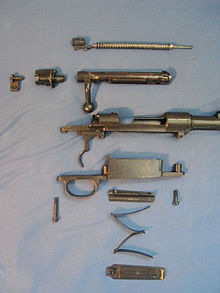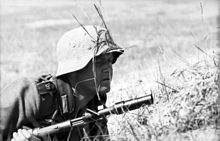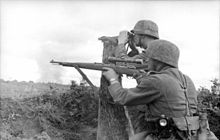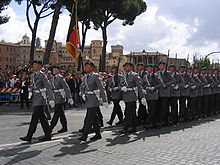- Karabiner 98k
-
Karabiner 98 Kurz 
Karabiner 98 kurzType Bolt-action rifle Place of origin  Nazi Germany
Nazi GermanyService history In service 1935–Present Used by See Users Wars Spanish Civil War, World War II, Second Sino-Japanese War, Korean War, First Indochina War, Chinese Civil War, Suez Crisis, Portuguese Colonial War, Algerian War, Greek Civil War, Vietnam War,[1] Six Day War, Yom Kippur War, Iran–Iraq War, Yugoslav wars,[1] Romanian Revolution, Iraq War, and current regional conflicts. Production history Designed 1935 Manufacturer Mauser Produced 1935–1945 Number built 14,643,260[2][3] Variants G40k Specifications Weight 3.7 kg (8.2 lb) - 4.1 kg (9.0 lb) Length 1,110 mm (43.70 in) Barrel length 600 mm (23.62 in) Cartridge 8x57mm IS Action Bolt-action Muzzle velocity 760 m/s (2,493 ft/s) Effective range 500 m (550 yd) with iron sights
800+ m (875+ yd) with telescopic sightFeed system 5-round stripper clip, internal magazine Sights Iron sights or telescopic sight. The Karabiner 98 Kurz (often abbreviated Kar98k, K98, or K98k) was a bolt action rifle chambered for the 8x57mm IS cartridge that was adopted as the standard service rifle in 1935 by the German Wehrmacht.[2] It was one of the final developments in the long line of Mauser military rifles. Although supplemented by semi- and fully automatic rifles during World War II, it remained the primary German service rifle until the end of World War II in 1945.
Contents
History
The Karabiner 98k was derived from earlier rifles, namely the Mauser Standardmodell and the Karabiner 98b, which in turn had both been developed from the Gewehr 98. Since the Karabiner 98k rifle was shorter than the earlier Karabiner 98b (the 98b was a carbine in name only, a version of Gewehr 98 long rifle with upgraded sights), it was given the designation Karabiner 98 Kurz, meaning "Carbine 98 Short". Just like its predecessor, the rifle was noted for its reliability, great accuracy and an effective range of up to 500 metres (550 yd) with iron sights.[4]
Design details
Features
The Karabiner 98k was a controlled-feed bolt-action rifle based on the Mauser M 98 system. It could be loaded with five rounds of 8x57mm IS ammunition from a stripper clip, loaded into an internal magazine. The straight bolt handle found on the Gewehr 98 bolt had been replaced by a turned-down bolt handle on the Karabiner 98k. This change made it easier to rapidly operate the bolt, reduced the amount the handle projected beyond the receiver, and enabled mounting of aiming optics directly above the receiver on the Karabiner 98k. Each rifle was furnished with a short length of cleaning rod, fitted through the bayonet stud. The rods from 3 rifles will make one full-length cleaning rod. The metal parts of the rifle were blued, a process in which steel is partially protected against rust by a layer of magnetite (Fe3O4). Such a thin black oxide layer provides minimal protection against rust or corrosion, unless also treated with a water-displacing oil to reduce wetting and galvanic corrosion.
Sights
Originally the Karabiner 98k iron sight line had an open post type front sight, and a tangent-type rear sight with a V-shaped rear notch. From 1939 onwards the post front sight was hooded to reduce glare under unfavourable light conditions and add protection for the post. These standard sight lines consisted of somewhat coarse aiming elements making it suitable for rough field handling, aiming at distant area fire targets and low light usage, but less suitable for precise aiming at distant or small point targets. The rear tangent sight was graduated for 1935 pattern 7.92x57mm IS cartridges from 100 m to 2000 m in 100 m increments. These cartridges were loaded with 12.8 g (197 gr) sS (schweres Spitzgeschoß – "heavy pointed bullet") ball bullets.
Stock
Most rifles had laminated stocks, the result of trials that had stretched through the 1930s. Plywood laminates are stronger and resisted warping better than the conventional one-piece patterns, did not require lengthy maturing and were cheaper. The laminated stocks were somewhat heavier compared to one-piece stocks.[5]
Accessories
When issued the Karabiner 98k came accompanied with assorted accessory items including a sling, a protective muzzle cover and for field maintenance a Reinigungsgerät 34 (Cleaning Kit 34) or RG34 kit. Introduced in 1934 the Reinigungsgerät 34 consisted of a flat 85 mm (3.3 in) wide by 135 mm (5.3 in) long sheet metal container with 2 hinged lids carried on the person which held an oiler, a take down tool for removing the floorplate and cleaning the receiver of the rifle, an aluminum barrel pull-through chain, a cleaning and an oiling brush, and short lengths of tow used as cleaning patches.[6]
The Karabiner 98k rifle was designed to be used with an S84/98 III bayonet.[7] The S84/98 III had a blade length of 252 mm (9.9 in) and an overall length of 385 mm (15.2 in) and was accompanied by a bayonet frog.[8] Older bayonet types designed for the Gewehr 98 could also be mounted and were used during World War II as well.[citation needed] Other accessories to fire rifle grenades or reduce the sound signature during firing were designed for the Karabiner 98k.
Rifle grenade launcher
As of 1942, an attachable rifle grenade launcher called the Gewehrgranatengerät or Schießbecher ("shooting cup") was introduced that was developed based on rifle grenade launcher models designed during World War I. The 30 mm Schießbecher cup-type rifle grenade launcher could be mounted on any Karabiner 98k and was intended to replace all previous rifle grenade launcher models. The rifle grenade launcher could be used against infantry, fortifications and light armored vehicles up to a range of 280 m (306 yd). For these differing tasks several specialized grenades with accompanying special propelling cartridges were developed for the 1,450,113 produced Schießbecher rifle grenade launchers. The rifle grenade propelling cartridges fired a wooden projectile through the barrel to the rifle grenade that upon impact automatically primed the rifle grenade. The Schießbecher could be mounted on the Karabiner 98a, G98/40, StG 44 and FG 42.[9]
Suppressor
A removable, muzzle-mounted HUB-23 suppressor, visually resembling the Schießbecher, was available for the Karabiner 98k. After several suppressor proposals from the fire arms industry and the SS-Waffenakademie (SS Weapons Academy) the HUB-23 was produced based on a design proposal by Unteroffizier Schätzle. The HUB-23 weighs 0.5 kg (1.1 lb) and is 180 mm (7.1 in) long. The maximum effective range of a Karbiner 98k with a HUB-23 mounted and firing special subsonic Nahpatrone (Near cartridge) reduced load ammunition with a muzzle velocity of 220 m/s (722 ft/s) was 300 m (330 yd). The use of the HUB-23 suppressor and subsonic ammunition resulted in a sound signature reduction by 75%.[10] The HUB-23 suppressor and the special subsonic ammunition were mainly used by special forces units such as the Brandenburgers and snipers.[citation needed]
Variants
Several special models of the Karabiner 98k existed.
Kriegsmodell
Starting in late 1944, Karabiner 98k production began transition to the "Kriegsmodell" ("war model") variant. This version was simplified to meet wartime production demands, removing the bayonet lug, cleaning rod, stock disc (which functions as a bolt disassembly tool), and other features deemed to be unnecessary.[11] At least two transitional variants existed, which incorporated only some Kriegsmodell features, and some factories never switched to Kriegsmodell production at all.
Sniper variant
For snipers, Karabiner 98k rifles selected for being exceptionally accurate during factory tests were fitted with a telescopic sight as sniper rifles. Karabiner 98k sniper rifles had an effective range up to 1000 meters (1094 yards) when used by a skilled sniper. The German Zeiss Zielvier 4x (ZF39) telescopic sight had bullet drop compensation in 50 m increments for ranges from 100 m up to 800 m or in some variations from 100 m up to 1000 m. There were ZF42, Zeiss Zielsechs 6x and other telescopic sights by various manufacturers like the Ajack 4x and 6x, Hensoldt Dialytan 4x and Kahles Heliavier 4x with similar features employed on Karabiner 98k sniper rifles. Several different mountings produced by various manufacturers were used. The Karabiner 98k was not designed for mounting telescopic sights.[12] Attaching such sights to a Karabiner 98k required machining by a skilled armourer. A telescopic sight mounted low above the center axis of the receiver will not leave enough space between the rifle and the telescopic sight body for unimpaired operation of the bolt handle or three-position safety catch lever. This ergonomic problem was solved by mounting the telescopic sight relatively high above the receiver and sometimes modifying or replacing the safety operating lever or using an offset mounting that positions the telescopic sight axis to the left side in relation to the receiver center axis. Approximately 132,000 of these sniper rifles were produced by Germany.[13]
Paratroopers
For German paratroopers special versions of the Karabiner 98k that could be transported in shortened modes were produced. Experimental specimens with folding stocks (Klappschaft) and with detachable barrels (Abnehmbarer Lauf) are known to have been produced at Mauser Oberndorf.[14]
G40k
The G40k with a total length of 1,000 mm (39.37 in) and a barrel length of 490 mm (19.29 in) and 3.2 kg (7.1 lb) weight was a shortened version of the Karabiner 98k.[13][14] A batch of 82 G40k rifles was produced in 1941.
A reverse engineering simulation with QuickLOAD internal ballistic software for the 8x57mm IS cartridge loaded with the German standard sS (schweres Spitzgeschoß/heavy pointed bullet) ball bullet, predicted that this shortening of the barrel results in ≈ 35 – 60 m/s muzzle velocity reduction depending on the propellant used. Due to its significant lighter weight the G40k produced ≈ 20% more recoil compared to the Karabiner 98k standard rifle.
German small arms doctrine
The Karabiner 98k had the same disadvantages as all other military rifles designed around the year 1900 in that it was comparatively bulky and heavy, having been created during a time when military doctrine centered around highly-trained marksmen engaging at relatively long range. The rate of fire was limited by how quickly the bolt could be operated. Its magazine had only half the capacity of Great Britain's Lee-Enfield series rifles, but being internal, it made the weapon more comfortable to carry at its point of balance. An experimental trench magazine was produced during World War II for Model 98 variants that could be attached to the bottom of the internal magazine by removing the floor plate, increasing capacity to 20 rounds, though it still required loading with 5 round stripper clips. While the Americans had standardized a semi-automatic rifle in 1936 (the M1 Garand), the Germans maintained these bolt-action rifles due to their tactical doctrine of basing a squad's firepower on the light machine gun so that the role of the rifleman was largely to carry ammunition and provide covering fire for the machine gunners. They did experiments with semi-automatic rifles throughout the war (the G43 entered limited service), and introduced the first assault rifle in 1943 - the MP43 / MP44 / StG44 series. However, the Karabiner 98k remained the primary service weapon until the last days of the war, and was manufactured until the surrender in May 1945.
In close combat, however, submachine guns were often preferred, especially for urban combat where the rifle's range and low rate of fire were not very useful, although the rifle's powerful ammunition was better able to penetrate walls and other cover found in urban areas. Towards the end of the war, it was intended to phase out the Karabiner 98k in favour of the StG44 , which fired the 7.92x33mm Kurz intermediate rifle round that was more powerful than the pistol cartridges of submachine guns, but that could be used like a submachine gun in close-quarters and urban fighting. Production of the StG44 was never sufficient to meet demand, being a late-war weapon.
Usage history
Pre–World War II export
Though most Karabiner 98k rifles went to the German armed forces, the weapon was sold abroad in the years prior to World War II. In Portugal, a large quantity of Karabiner 98k rifles made by Mauser Werke were adopted as the Espingarda 7,92 mm m/937 Mauser infantry rifle.[15][16] Sweden ordered 2,500 Kar 98ks that were provided from the regular production run in 1939.[17] Sweden had adopted a special cartridge for their machine guns, the 8x63mm M32, which was a very powerful round and used only by Sweden. It was used in specially-chambered Browning machine guns, and the Kar98ks were purchased so the machine gun troops could have rifles that fired the same round. Accordingly, the Kar 98ks were re-chambered in Sweden for the 8x63mm and the magazine opened up to accept it. A muzzle brake was installed to reduce the heavy recoil generated, and the resulting weapon designated M40 in Swedish service. After World War II, the Swedes discontinued use of the 8x63mm cartridge and the rifles were sold to Israel. Other pre-war exports of Kar 98ks were to China (an unknown number of rifles 1935 - 38),[18] and 20,000 in 1937 to (China's then-enemy) Japan.[19] Exports of Kar 98ks decreased as war drew closer, as all available production capacity was needed to equip the German Armed Forces.
World War II use
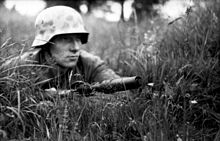 A concealed German soldier in northern France, 1944. His Karabiner 98k is equipped with a Gewehrgranatgerät cup-type grenade launcher attachment.
A concealed German soldier in northern France, 1944. His Karabiner 98k is equipped with a Gewehrgranatgerät cup-type grenade launcher attachment.
The Mauser Karabiner 98k rifle was widely used by all branches of the armed forces of Germany during World War II. It saw action in every theatre of war involving German forces, including occupied Europe, North Africa, the Soviet Union, Finland, and Norway. Although comparable to the weapons fielded by Germany's enemies at the beginning of the War, its disadvantages in rate of fire became more apparent as American and Soviet armies began to field more semi-automatic weapons among their troops. Still, it continued to be the main infantry rifle of the Wehrmacht until the end of the War. Resistance forces in German-occupied Europe made frequent use of captured German Karabiner 98k rifles. The Soviet Union also made extensive use of captured Karabiner 98k rifles and other German infantry weapons due to the Red Army experiencing a critical shortage of small arms during the early years of World War II. Many German soldiers used the verbal expression "Kars" as the slang name for the rifle.
Post–World War II use
Soviet Capture
During World War II, the Soviet Union captured millions of Mauser Karabiner 98k rifles and re-furbished them in various arms factories in the late 1940s and early 1950s. These rifles were originally stored in the event of future hostilities with the Western Bloc. These rifles, referred to by collectors as RC ("Russian Capture") Mausers, can be identified by a crude "X" stamp on the left side of the receiver, the dull, thick reblueing and mismatched parts and electro-pencil serial numbers on smaller parts. The Soviet arsenals made no effort to match the rifle's original parts by serial number when reassembling them, and some parts (the cleaning rod, sight hood, and locking screws) were deemed unnecessary and melted down for scrap metal.
Most of these rifles (along with the Mosin-Nagant rifle) were eventually shipped to communist or Marxist revolutionary movements and nations around the world during the early Cold War period. A steady supply of free surplus military firearms was one way that Moscow could support these movements and states whilst retaining plausible deniability as well as give Moscow a means to arm these governments and movements without providing them the latest Soviet infantry weapons (these governments and movements Moscow supported would be provided modern infantry weapons like the SKS and the AK-47 at a later date).
One example of the Soviet Union providing the Mauser Karabiner 98k rifle (as well as other infantry weapons captured from the Germans during and after World War II) to its communist allies during the Cold War period occurred during the Vietnam War with the Soviet Union providing military aid to the armed forces of North Vietnam and to the NLF in South Vietnam.
A considerable number of Soviet-captured Mauser Karabiner 98k rifles (as well as a number of Karabiner 98k rifles that were left behind by the French after the First Indochina War) were found in the hands of NLF (Vietcong) guerrillas and VPA (NVA) soldiers by US, South Vietnamese, South Korean, Australian and New Zealand forces alongside Soviet-bloc rifles like the Mosin-Nagant, the SKS, and the AK-47.
Post-occupation service
In the years after World War II, a number of European nations on both sides of the Iron Curtain that were invaded and occupied by Nazi Germany used the Mauser Karabiner 98k rifle as their standard-issue infantry rifle, due to the large number of German weapons that were left behind by the Germans at the end of World War II.
Nations like France and Norway used the Mauser Karabiner 98k rifle and a number of other German weapons in the years after World War II.
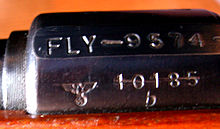 The emblem of Nazi Germany, eagle with swastika, is still visible on many of the rifles that were used by the Norwegian military. The "FLY" prefix to the serial number denotes that this rifle was issued to the Flyvåpenet (Air Force).
The emblem of Nazi Germany, eagle with swastika, is still visible on many of the rifles that were used by the Norwegian military. The "FLY" prefix to the serial number denotes that this rifle was issued to the Flyvåpenet (Air Force).
Norway's captured Karabiner 98k rifles were soon superseded as a standard issue weapon by the US M1, but remained in service as Norwegian Home Guard weapons until at least the 1970s, in which role they were rebarreled for the .30-06 Springfield round used by the M1, with a small cutout in the receiver so that the slightly longer US round could still be loaded with stripper clips. These Norwegian conversions had a section of the receiver flattened on the upper left side, where a new serial number (with a prefix denoting the branch of service) was stamped. Some of these rifles conversions were rechambered again to 7.62 mm NATO, but this program was canceled with only a few thousand converted when Norway adopted the AG-3 (H&K G3) as a replacement for both the M1 and the K98k. Some actions from Mauser Karabiner 98k left by German armed forces in 1945 were used by Kongsberg Våpenfabrikk (currently Kongsberg Small Arms) for building both military and civilian sniper/target rifles under the Kongsberg Våpenfabrikk Skarpskyttergevær M59 - Mauser M59 and Kongsberg Våpenfabrikk Skarpskyttergevær M67 - Mauser M67 designations. These rifles were used by the Norwegian armed forces up to the 2000s.
Former German Karabiner 98k rifles were widely distributed throughout the Eastern Bloc, some being refurbished 2 or 3 times by different factories. They were used by military and para-military forces (such as the East German Combat Groups of the Working Class), and were replaced by Soviet weapons in the 1960s.
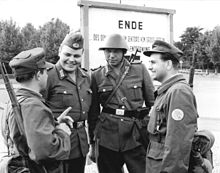 East German members of the Combat Group of the Working Class and Border Troops at the border of the Berlin sector in 1961. The Combat Group members are equipped with Karabiner 98k rifles.
East German members of the Combat Group of the Working Class and Border Troops at the border of the Berlin sector in 1961. The Combat Group members are equipped with Karabiner 98k rifles.
East German refurbished Karabiner 98ks featured Russian-style thicker blue finish, a 'sunburst' proof mark and sometimes had the factory designation '1001' applied, which was the factory where the refurbishment was carried out. Numbers were re-stamped to match the receiver and old numbers barred out. Numbers of East German and Czech refurbished Karabiner 98ks were exported to the West in the late 1980s and early 1990s and are now in the hands of collectors. Russian Capture Karabiner 98ks were exported to the West in large numbers in the early- and mid- 2000s. A small number of Karabiner 98k rifles were ordered by East Germany from Czechoslovakia in 1950,[citation needed] and are true 98k pattern rifles with bent bolt handle and stock inlet. Due to the Warsaw Pact practice of donating older or obsolete weapons to Socialist/Revolutionary governments/movements in the third world, very few exist in private hands, making it among the rarest Karabiner 98k rifles ever manufactured.
The Yugoslavian arms producer Zastava Arms refurbished German Karabiner 98k rifles. These Prеduzeće 44 rifles are readily identifiable as the German factory code markings have been scrubbed from the receiver and replaced with the Yugoslav communist crest. The refurbished Prеduzeće 44 Karabiner 98k rifles were still being used in the Balkan wars of the 1990s.
Post–World War II derivatives
Many of the liberated European countries continued production of rifles similar to the Karabiner 98k, for example Fabrique Nationale (FN) in Belgium and Česká Zbrojovka (CZ) in Czechoslovakia produced both their proprietary older models and brand new Karabiner 98k rifles, many of which were assembled from leftover German parts or using captured machinery.
As with post-Nazi occupation service post-war production of derivatives was a stop-gap solution until enough numbers of more modern automatic rifles could be developed and produced. The vast majority of the 98K pattern rifles were soon stored as reserve weapons or given for very low prices to various fledgling states or rebel movements throughout the developing world.
Both FN and CZ utilized a modified Kriegsmodell design, with the cleaning rod and stock disk still omitted, but the bayonet lug restored. In Czechoslovakia it was known as P-18 or puška vz.98N, the first being the manufacturer's cover designation of the type, the second official army designation - rifle model 98, N for německá - German. In Romania, the Czechoslovak version was known under the informal name of ZB, after Zbrojovka Brno - the Czechoslovak state producer of small weapons and munitions - and it was used to arm Romania's Patriotic Guards.
Yugoslavian M48
From 1950 to 1965, Yugoslavian Zastava Arms produced a near-copy of the Karabiner 98k imported between the wars from Fabrique Nationale called the Model 1948, which differed from the German rifle in that it had the shorter bolt-action of the Yugoslav M1924 series of rifles (not to be confused with the widely-distributed Czech Vz 24 which had a standard length action), a stronger barrel (Yugoslavia had low chromium deposits, so they could not produce steel as hardened as Krupp- or Sweden-steel used in other variants, and made up for it in material strength), and a rear sight enclosed in the wooden hand guard (the German-style hand guard began in front of the rear sight, unlike e.g. exports to South America that had a hand guard and rear sight like the M48).
Spanish M43
The Spanish M43, produced in La Coruña until 1957,[citation needed] was a variant of the 98k with a straight bolt handle, a front sight guard and a handle groove in the front stock much like the earlier Reichspostgewehr. It was chambered in 8x57 IS calibre. When Spain began switching to the CETME automatic rifle, many M43 were converted to FR8 rifles for military training purposes and Guardia Civil service.
Israeli Mauser
A number of non-European nations used the Mauser Karabiner 98k rifle as well as a few guerrilla organizations to help establish new nation-states. One example was Israel who used the Mauser Karabiner 98k rifle from the late 1940s until the 1970s.
The use of the Karabiner 98k to establish the nation-state of Israel often raises a lot of interest among people and rifle collectors today. Many Jewish organizations in Palestine acquired them from post–World War II Europe to protect various Jewish settlements from Arab attack as well as to carry out guerrilla operations against British Army forces in Palestine.
The Haganah, which later evolved into the modern-day Israel Defense Forces, was one of the Jewish armed groups in Palestine that brought large numbers of Mauser Karabiner 98k rifles and other surplus arms (namely the British Lee-Enfield bolt-action rifle, which was used on a large scale by these groups and the Mosin-Nagant) from Europe during the post–World War II period. Many, though not all, Israeli-used German surplus Mauser Karabiner 98k rifles have had all of the Nazi Waffenamt markings and emblems defaced with over stamped Israel Defence Force (IDF) and Hebrew markings as part of an effort to ideologically "purify" the rifles from their former use as an infantry weapon of Nazi Germany.
As the Arab-Israeli conflict approached, the Haganah and other Jewish forces in Palestine tried to get hold of as many weapons as they could in the face of an arms embargo by British colonial authorities. One of most important purchases was a secret January 14, 1948, $12,280,000 worth contract with Czechoslovak Government including 4,500 P-18 rifles, as well as 50,400,000 rounds of ammunition. Later, the newly established Israel Defence Force ordered more numbers of Mauser Karabiner 98k rifles, produced this time by Fabrique Nationale. These have Israeli and Belgian markings on the rifle as well as the emblem of the IDF on the top of the rifle's receiver. The FN-made Karabiner 98k rifles with the IDF markings and emblem on the rifle were produced and sold "legally" to Israel after it established itself as an independent nation in 1948. The Israeli Karabiner 98k utilized the same bayonet design as in German service, with a barrel ring added. The Israeli bayonets were a mix of converted German production and domestically produced examples.
During the late 1950s, the IDF converted the calibre of their Mauser Karabiner 98k rifles from the original German 7.92 mm round to 7.62 mm NATO following the adoption of the FN FAL rifle as their primary rifle in 1958. The Israeli Mauser Karabiner 98k rifles that were converted have "7.62" engraved on the rifle receiver. Rifles with original German stocks have "7.62" burned into the heel of the rifle stock for identification and to separate the 7.62 NATO rifles from the original 7.92 mm versions of the weapon still in service or held in reserve. Some Karabiner 98k rifles were fitted with new, unnumbered beech stocks of recent manufacture, while others retained their original furniture. All of these converted rifles were proof-fired for service.
The Karabiner 98k rifle was used by the reserve branches of the IDF well into the 1960s and 1970s and saw action in the hands of various support and line-of-communications troops during the 1967 Six-Day War and the 1973 Arab-Israeli War. After the rifle was retired from reserve military service, the Israeli Mauser Karabiner 98k was given to a number of Third World nations as military aid by the Israelis during the 1970s and 1980s, and sold as ex-military surplus on the open market.
Contemporary use
The Bundeswehr still uses the Karabiner 98k in the Wachbataillon for military parades and show acts. In 1995 remaining swastikas and other Nazi-era markings were removed from these rifles, after criticism regarding the presence of such symbols on Wachbataillon kit by the SPD parliamentary party.[20]
During the 1990s, the Yugoslavian Karabiner 98k rifles and the Yugoslavian M48 and M48A rifles were used alongside modern automatic and semi-automatic rifles by all the warring factions of the Yugoslav wars. There are a number of photographs taken during the war in Bosnia, showing combatants and snipers using Yugoslavian-made Mauser rifles from high-rise buildings in the Bosnian city of Sarajevo.[21]
The Norwegian Army currently (2008) use the Våpensmia NM149 and NM149-F1 sniper rifles which are based on Karabiner 98k bolt actions. Besides Mauser M 98 system actions, captured by Norway at the end of World War II in 1945, contemporary components originating from several manufacturers are used by Våpensmia A/S to build the NM149 and NM149-F1.
The Karabiner 98k is still used by San Marino's Guardia di Rocca.[citation needed]
Since 2003, the Mauser Karabiner 98k rifle (along with the Mosin-Nagant, the Lee-Enfield and the Yugoslavian M48) has been encountered in Iraq by US and Allied forces with Iraqi insurgents making use of the Karabiner 98k and other bolt-action rifles alongside more modern infantry weapons like the AK series rifles and the SKS carbine. The extra range afforded by the 7.92x57mm IS cartridge still makes it a viable low-cost marksmen rifle for the insurgents.
Many Third World nations still have Karabiner 98k rifles in their arsenals and it will most likely be encountered in regional conflicts for many years to come.
In the 2011 Libyan Civil War some rebels have been seen carrying Mauser Karabiner 98k rifles along with more modern weapons.
Civil use
The Karabiner 98k rifles that were used by Germany during World War II are highly sought after collector's items in many circles. The Mauser Karabiner 98k rifle remains popular among many rifle shooters and military rifle collectors due to the rifle's historical background, as well as the availability of both new and surplus 8x57mm IS ammunition. As of 2010[update], the Mauser Karabiner 98k rifles that were captured by the Soviets during World War II and refurbished during the late 1940s and early 1950s have appeared in large numbers on the military surplus rifle market. These have proven popular with buyers in the United States and Canada, ranging from ex-military rifle collectors to target shooters and survivalists, due to the unique history behind the Soviet capture of Mauser Karabiner 98k rifles.
The widespread availability of surplus Mauser 98k rifles and the fact that these rifles could, with relative ease, be adapted for hunting and other sport purposes made the Mauser 98k popular amongst civilian riflemen. When German hunters after World War II were allowed again to own and hunt with full bore rifles they generally started to "rearm" themselves with the then abundant and cheap former Wehrmacht service rifles. Civilian users changed these service rifles often quite extensively by mounting telescopic sights, aftermarket hunting stocks, aftermarket triggers and other accessories and changing the original military chambering. Gunsmiths rebarreled or rechambered Mauser 98K rifles for European and American sporting chamberings such as the 6.5 x 55 Swedish Mauser, 7 x 57, 7 x 64, .270 Winchester, .308 Winchester, .30-06 Springfield, 8 x 60 S, 8 x 64 S, etc. The magnum hunting cartridges 6.5 x 68, 8 x 68 S and 9.3 x 64 Brenneke were even specially developed by German gunsmiths for the standard military Mauser 98 action.
Surplus Mauser 98K actions were used by Schultz & Larsen in Denmark as the basis for target rifles. The actions had the German markings removed, were refinished in gray phosphate, and new serial numbers and proof marks applied. The Schultz & Larsen M52 and M58 Target Rifles used shortened and refurbished Karabiner 98k stocks. Later versions had new target stocks fitted and were available in .30-06, 6.5x55mm and 7.62mm NATO. Some of these rifles are still in competitive use today although with the benefit of new barrels. Besides conversions of original Karabiner 98k rifles other sporter variants made by a number of manufacturers such as FN Herstal, Zastava, Santa Barbara (Spain) and many others have been available at various times in a wide variety of chamberings, but most are large-bore hunting calibers.
Modern civilian offspring
Throughout the design's history, standard sized and enlarged versions of the Mauser M 98 system have been produced for the civil market.
John Rigby & Co. commissioned Mauser to develop the M 98 magnum action over a hundred years ago. It was designed to function with the large sized cartridges normally used to hunt Big Five game and other dangerous game species. For this specialized type of hunting, where absolute reliability of the rifle under adverse conditions is very important, the controlled-feed M 98 system remains the standard by which other action designs are judged.[22]
Zastava Arms currently (2010) manufactures the M48/63 sporting rifle which is a short barreled variant of the Model 1948 military rifle and the Zastava M07 sniper rifle.[23][24]
Since 1999 the production of Mauser M 98 and M 98 Magnum rifles has been resumed in Germany by Mauser Jagdwaffen GmbH[25] (Mauser Huntingweapons Ltd.) according to original drawings of 1936 and the respective Mauser patents.
Users
 People's Republic of China[26]
People's Republic of China[26] Republic of China[27]
Republic of China[27] Croatia[1]
Croatia[1] Czechoslovakia (post 1945)[26]
Czechoslovakia (post 1945)[26] Denmark[26]
Denmark[26] East Germany[26]
East Germany[26] France[26]
France[26] Germany[26]
Germany[26] Indonesia[28]
Indonesia[28] Israel[26]
Israel[26] Luxembourg: The Grand Ducal Guard used captured German K98k's in 1945, later replaced by Ross rifles in the same year.[29]
Luxembourg: The Grand Ducal Guard used captured German K98k's in 1945, later replaced by Ross rifles in the same year.[29] Nazi Germany[30]
Nazi Germany[30] Norway[31]
Norway[31] Portugal[32]
Portugal[32] San Marino: still used by the Guardia di Rocca.
San Marino: still used by the Guardia di Rocca. Serbia[1]
Serbia[1] Slovakia[33]
Slovakia[33] Sweden: Imported 5,000 Kar 98k rifles in 1939.[34]
Sweden: Imported 5,000 Kar 98k rifles in 1939.[34] Turkey[28]
Turkey[28] Yugoslavia[26]
Yugoslavia[26] Pakistan (post 1945)
Pakistan (post 1945) Ethiopia: Abyssinian patriots used captured K98k's against occupying Axis forces from 1941-onwards.[35]
Ethiopia: Abyssinian patriots used captured K98k's against occupying Axis forces from 1941-onwards.[35]
Non-state actors
- Korean Liberation Army (a group that fought for the independence of Korea during the Japanese colonization period (1910–1945)).[26]
See also
- Kbk wz. 1929
- vz. 24
- Chiang Kai-shek rifle
- M48 Mauser
- M24 series
References
- ^ a b c d Bishop, Chris. Guns in Combat. Chartwell Books, Inc (1998). ISBN 0-7858-0844-2.
- ^ a b K98k Mauser Page Retrieved 28 March 2007.
- ^ French K98k and G40k Page - go to "sommaire" at the bottom of the page to use the index (French)
- ^ Bishop, Chris (1998). The Encyclopedia of Weapons of World War II. New York: Orbis Publishing Ltd. ISBN 0-7607-1022-8.
- ^ Ball, Robert W.D. (2011). Mauser Military Rifles of the World (5 ed.). Gun Digest Books. p. 227. ISBN 9781440215445.
- ^ "Rifle Cleaning Kit 34 (Reinigungsgerät 34)". http://www.mp44.nl/equipment/rg34.htm.
- ^ REME Museum Page S84/98 III bayonet
- ^ "German Bayonets for the Mauser 98-system used 1914-1945". http://www.gotavapen.se/gota/artiklar/98bayonets/98bayonets3.htm.
- ^ "Der Schießbecher (Gewehrgranatengerät)" (in German). http://www.whq-forum.de/cms/604.0.html.
- ^ "Lexicon der Wehrmacht Gewehre" (in German). http://www.lexikon-der-wehrmacht.de/Waffen/gewehre.htm.
- ^ Firearms of the Wehrmacht - Mauser Karabiner 98
- ^ Senich, Peter R. (1982). The German sniper, 1914-1945 (1982 ed.). Paladin Press. ISBN 9780873642231.
- ^ a b French K98k and G40k Page
- ^ a b Karabiner 98k at www.waffenhq.de
- ^ Abbott, Peter, and Rodrigues, Manuel, Modern African Wars 2: Angola and Mozambique 1961-74, Osprey Publishing (1998), p.17
- ^ Reynolds, Dan, The Rifles of Portugal 1880-1980, http://www.carbinesforcollectors.com/port.html
- ^ Law, Richard D., "Backbone of the Wehrmacht, Collector Grade Publications, Ontario, 1993, p320
- ^ Law, Richard D., "Backbone of the Wehrmacht, Collector Grade Publications, Ontario, 1993, p308-9
- ^ Law, Richard D., "Backbone of the Wehrmacht, Collector Grade Publications, Ontario, 1993, p310
- ^ DER SPIEGEL 38/1995 Seite 16a vom 18. September 1995, Staatsbesuche - Hakenkreuze präsentiert accessed 6 May 2008
- ^ M48 Mauser Sniper Rifle
- ^ John Rigby & Co. - Rigby African Express Bolt Rifle
- ^ SPORTING RIFLE M48/63
- ^ Sniper Rile 07
- ^ Mauser Jagdwaffen GmbH
- ^ a b c d e f g h i "Mauser Bolt Rifles by Ludwig Olsen, 3rd edition, F. Brownell and Son, Publisher, p. 126
- ^ Ball, Robert: Mauser Military Rifles of the World Gun Digest Books, 2006
- ^ a b Brassey's Infantry Weapons of the World, 1950-1975, J.I.H Owen (1975), p. 57
- ^ GRAND-DUCHY OF LUXEMBOURG
- ^ http://books.google.com/books?id=JZ9cSQNeK9cC&pg=PA216&dq=karabiner+98k#v=onepage&q=karabiner%2098k&f=false
- ^ Ball, Robert: Mauser Military Rifles of the World. Gun Digest Books, 2006
- ^ Ball, Robert: Mauser Military Rifles of the World. Gun Digest Books, 2006
- ^ Axworthy, Mark W.(2002), Axis Slovakia: Hitler's Slavic Wedge 1938-1945,Europa Books Inc.,ISBN 1891227416
- ^ Swedish rifles - Gev m/39 and m/40 gotavapen.se
- ^ Unwin, Charles C.; Vanessa U., Mike R., eds (2002). 20th Century Military Uniforms (2nd ed.). Kent: Grange Books. ISBN 1840132763.
External links
German Mauser Kar98k rifle
- K98k Page
- cruffler.com
- Mauser 98k rifle
- world.guns.ru
- Saving Private Ryan Online Encyclopedia (contains a number of pictures of the Mauser Kar98k rifle from the movie)
- Nazarian's Gun Recognition Guide – Video of the Mauser Kar98k rifle in action
- German K98k Page (German)
- French K98k and G40k Page – go to "sommaire" at the bottom of the page to use the index (French)
- Information and pictures of the Mauser Kar98k rifle (Italian)
- information and pictures of the Czech Mauser Kar98k rifle (Italian)
- Technical drawings of the Mauser Karabiner 98k rifle
- MAUSER KAR. 98K RIFLE US Military Intelligence Service, Special Series No. 14, May 25, 1943
Israeli Mauser Kar98k rifle
- cruffler.com
- Carbines For Collectors (contains a bit of history on the Mauser Kar98k rifle and its use by Israel)
- SurplusRifle.com (contains information and history on the Mauser Kar98k rifle's use by Israel)
- Information and pictures of the Israeli Mauser Kar98k rifle
Yugoslav Mauser M48 rifle
Modern civilian offspring of the Mauser 98K
German firearms and light weapons of World War IISide arms (Pistolen) Mauser C96 · Luger · Walther P38 · Walther PP and PPK · Sauer 38H · Mauser HSc · Dreyse M1907 Pistol · VolkspistoleRifles & carbines (Gewehre & Karabiner) Karabiner 98k · G 24(t) · G 33/40(t) · G 98/40 · Gewehr 41 · Gewehr 43/Karabiner 43 · MP 43/MP 44/StG 44 · FG 42 · M30 Luftwaffe drilling · StG 45(M) · VG 1-5 · Wimmersperg Spz-krSubmachine guns (Maschinenpistolen) Machine guns & other larger weapons MG 08 · VMG-27 · Schwarzlose MG M.07/12 · MG 13 · MG 15 · MG 26 · MG 30 · MG 34 · MG 42 · MG 45 · IMG 28 · MG 35/36A · Faustpatrone · Raketen-Panzerbüchse 43 · Panzerfaust · Panzerschreck · Fliegerfaust/Luftfaust · Flammenwerfer 35 · Einstossflammenwerfer 46 · Panzerbüchse 39 · Solothurn S-18/1000Mortars (Granatwerfer) Grenades (Granaten) Notable foreign-made infantry weapons German-made cartridges used by the Wehrmacht 8×57mm IS · 7.63×25mm Mauser · 8x33mm Kurz · 7.65×22mm Parabellum · 9×19mm Parabellum · 13.2×92mmSR · 7.92×94mmWeapons and military equipment designed or licence-manufactured in IranFirearms PistolsArmour and other
land based vehiclesArtillery MRLS Recoilless rifles Mortars 37mm Marsh Mortaranti-aircraft guns Anti-tank missiles RPG-7 · Saegheh (rocket) · Type 69 RPG · RPG-29 · RAAD · Saeghe · Toophan · Toophan 2 · Towsan · 9K115-2 Metis-MCategories:- 8 mm firearms
- 1935 introductions
- Bolt-action rifles
- Carbines
- Curio and relic firearms
- Mauser rifles
- Weapons of Portugal
- World War II German infantry weapons
- World War II Iranian infantry weapons
- Rifles of Germany
Wikimedia Foundation. 2010.

